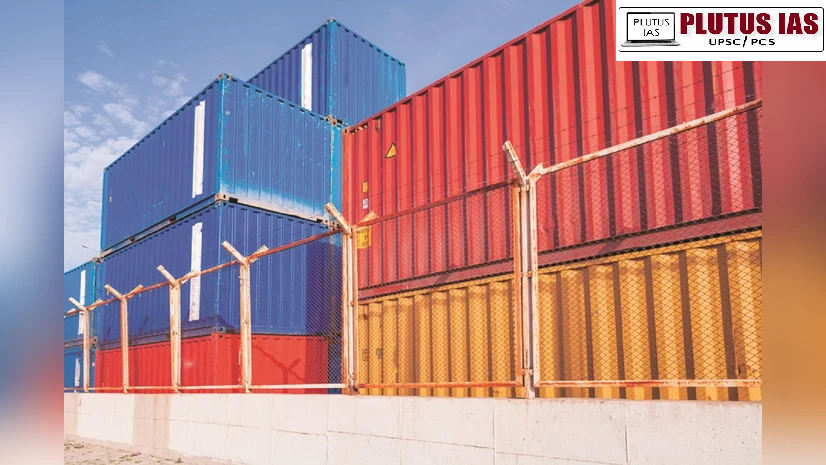Merchandise Trade Performance
1. Trade Deficit: India’s merchandise trade deficit narrowed to $18.78 billion in June 2025 from $21.88 billion in May, reflecting better external sector balance.
2. Export Trends: Exports remained stable, driven by engineering goods, pharmaceuticals, electronics, and select agri-products.
3. Import Decline: Imports fell notably due to a drop in non-essential items and lower demand, aiding in narrowing the trade gap.
4. Crude Oil Imports: Lower crude oil imports, due to stable prices and seasonal demand dip, significantly contributed to the reduced deficit.
5. Gold Imports: Gold imports declined amid high prices and weak jewellery demand, especially outside festive months.
6. Month-on-Month (MoM) View: Compared to May 2025, the fall in imports was sharper than changes in exports, improving the overall trade position.
7. Year-on-Year (YoY) View: Versus June 2024, the deficit is narrower, indicating better export resilience and success in import substitution strategies.
Services Trade Resilience
1. Strong Surplus: India recorded a services trade surplus of $15.62 billion in June 2025, helping cushion the overall trade deficit.
2. Export Performance: Services exports stood at $32.84 billion, led by growth in IT, financial, and professional services.
3. IT Sector Leadership: India’s IT and software services remain global leaders, with consistent demand from the U.S., EU, and emerging markets.
4. Consulting & Financial Growth: Consultancy, legal, fintech, and back-office services are expanding, boosted by digital transformation globally.
5. Global Services Hub: India continues to serve as a global outsourcing and digital services hub, supported by a skilled English-speaking workforce.
6. Support for CAD: The strong services surplus is crucial in narrowing the Current Account Deficit (CAD) and stabilizing forex reserves.
7. Policy Support: Government focus on digital trade frameworks, skilling, and export incentives is enhancing India’s global service competitiveness.
India–U.S. Trade Dynamics
1. Export Growth: India’s exports to the U.S. rose from $14.17 billion (Apr–May 2024) to $17.25 billion (Apr–May 2025), a strong YoY growth.
2. Top Export Destination: The U.S. remains India’s largest export market, especially for pharma, software, textiles, machinery, and diamonds.
3. Tariff Concerns: Concerns over possible Trump-era tariff revival persist, though current trade remains unaffected.
4. Negotiation Momentum: Ongoing trade talks aim to address market access, digital trade, and tariff barriers, improving bilateral cooperation.
5. Technology Partnerships: Collaborations in semiconductors, AI, defence tech, and clean energy are boosting bilateral trade value.
6. Indian Diaspora’s Role: The strong Indian-American community fosters business linkages, tech partnerships, and support for pro-India policies.
7. Strategic Trade Pillar: India–U.S. trade forms a strategic pillar of Indo-Pacific relations, balancing economic and geopolitical interests.
Tariff Threats and Geopolitical Pressures
1. Revival of Tariff Threats: Rhetoric from the U.S. signals a potential return to Trump-era protectionist tariffs, creating trade uncertainty.
2. WTO Concerns: India is pushing back at the WTO against discriminatory tariffs, seeking rule-based global trade fairness.
3. Global Protectionism: Rising protectionist trends globally, including in the U.S. and EU, threaten India’s export competitiveness.
4. India’s Diversification Strategy: India is reducing dependency on single markets by diversifying exports to Africa, ASEAN, and Latin America.
5. FTA Engagements: India’s FTAs with UAE, Australia, and talks with UK, EU, Canada help counter trade barriers elsewhere.
6. Resilient Export Planning: Focus on value-added exports, local manufacturing, and quality standards helps India weather tariff shocks.
7. Strategic Diplomacy: India is using strategic diplomacy and economic dialogues (e.g., QUAD, IPEF) to manage trade friction and ensure market access.
Conclusion
India has demonstrated remarkable resilience in the global trade landscape, primarily through the strength of its services sector and a balanced trade policy approach. However, to sustain this momentum, it is crucial to diplomatically address ongoing trade tensions and protect national interests. The strategic focus must remain on reinforcing surplus-generating sectors such as IT and pharmaceuticals while promoting new areas of export growth. Additionally, diversification of trade partners and products is essential to reduce dependency and enhance long-term stability
Prelims Questions





No Comments